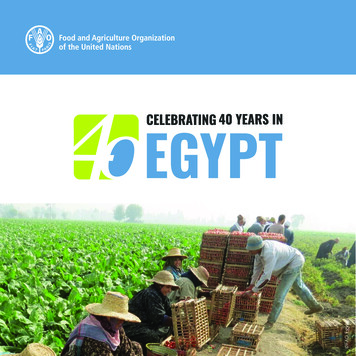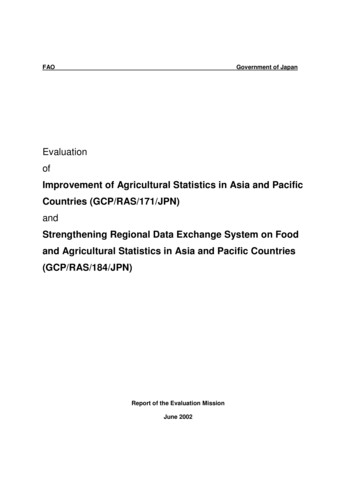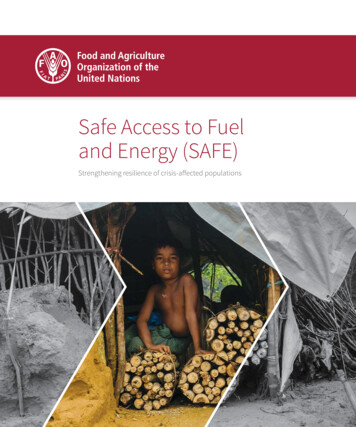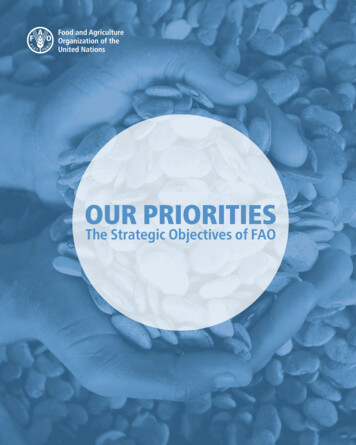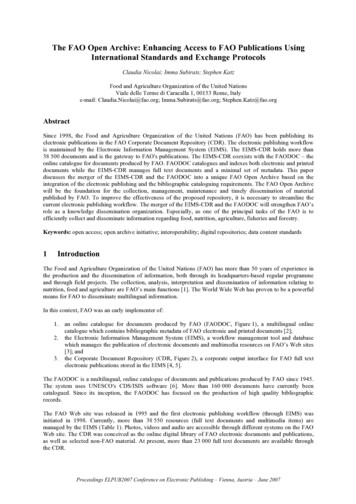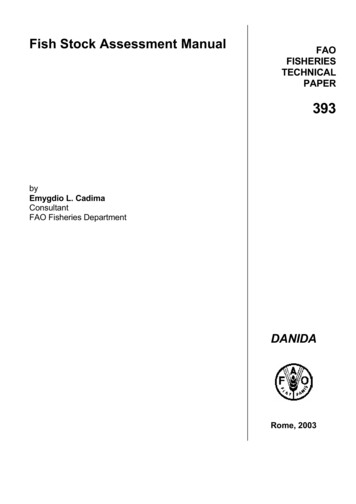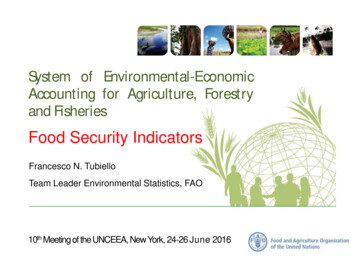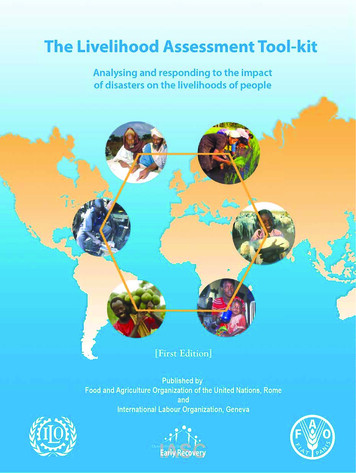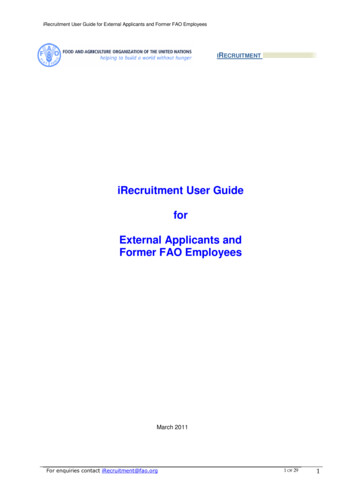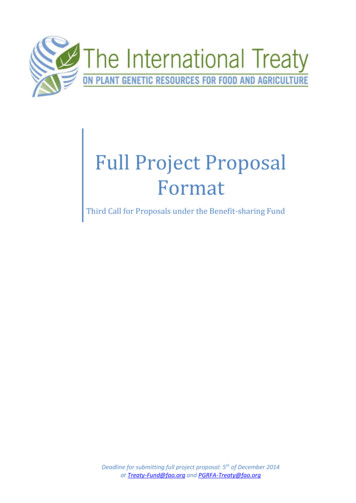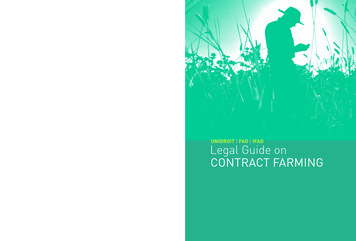
Transcription
UNIDROIT FAO IFADLegal Guide onCONTRACT FARMINGContract farming, broadly understood as agriculturalproduction and marketing carried out under a previousagreement between producers and their buyers,supports the production of a wide range of agriculturalcommodities and its use is growing in many countries.Mindful of the importance of enhancing knowledge andawareness of the legal regime applicable to contractfarming operations, the International Institute for theUnification of Private Law (UNIDROIT), the Food andAgriculture Organization of the United Nations (FAO)and the International Fund for Agricultural Development(IFAD) have prepared this UNIDROIT/FAO/IFAD Legal Guideon Contract Farming.The Guide is a useful tool and reference point for abroad range of users involved in contract farming practice,policy design, legal research and capacity-building. It cancontribute as well to create a favourable, equitable andsustainable environment for contract farming.Legal Guide on CONTRACT FARMINGUNIDROIT FAO IFADUNIDROIT FAO IFADLegal Guide oncontract farming
UNIDROIT FAO IFADLegal Guide onCONTRACT FARMINGInternational Institute for the Unification of Private LawFood and Agriculture Organization of the United NationsInternational Fund for Agricultural DevelopmentRome, 2015
Recommended citationUNIDROIT, FAO and IFAD. 2015. UNIDROIT/FAO/IFAD Legal Guide on Contract Farming. RomeCover artwork and design: Simone MoriniCover photo: FAO/Sergey KozminThis UNIDROIT/FAO/IFAD Legal Guide on Contract Farming is a joint publication of the InternationalInstitute for the Unification of Private Law (UNIDROIT), the Food and Agriculture Organization of theUnited Nations (FAO) and the International Fund for Agricultural Development (IFAD).The designations employed and the presentation of material in this information product do not implythe expression of any opinion whatsoever on the part of UNIDROIT, FAO and IFAD concerning thelegal or development status of any country, territory, city or area or of its authorities, or concerningthe delimitation of its frontiers or boundaries. The mention of specific companies or products ofmanufacturers, whether or not these have been patented, does not imply that these have beenendorsed or recommended by UNIDROIT, FAO or IFAD in preference to others of a similar nature thatare not mentioned. The views expressed in the work do not necessarily reflect the views or policies ofFAO or IFAD.ISBN 978-88-86449-30-4 UNIDROIT, FAO and IFAD, 2015UNIDROIT, FAO and IFAD encourage the use, reproduction and dissemination of material in thisinformation product. Except where otherwise indicated, material may be copied, downloaded andprinted for private study, research and teaching purposes, or for use in non-commercial productsor services, provided that appropriate acknowledgement of UNIDROIT/FAO/IFAD as the source andcopyright holders is given and that UNIDROIT/FAO/IFAD’s endorsement of users’ views, products orservices is not implied in any way.All requests for translation and adaptation rights, and for resale and other commercial use rightsshould be made via ications or addressed topublications@unidroit.org.UNIDROIT information products are available on the UNIDROIT website lications) and can be purchased through publications@unidroit.org.FAO information products are available on the FAO website (www.fao.org/publications) and can bepurchased through publications-sales@fao.orgIFAD information products are available at IFAD website (www.ifad.org)
FOREWORDContract farming, broadly understood as agricultural production andmarketing carried out under a previous agreement between producers andtheir buyers, supports the production of a wide range of agriculturalcommodities and its use is growing in many countries.Contract farming helps increase agricultural productivity, improve thelivelihoods of the rural poor and may play a role in preventing rural exodus.These and other potential economic and social benefits explain the interest ofmany domestic policymakers and international organizations in promotingsustainable contract farming models as part of their efforts to achieve foodsecurity.Mindful of the importance of enhancing knowledge and awareness of thelegal regime applicable to contract farming operations, the InternationalInstitute for the Unification of Private Law (UNIDROIT), the Food andAgriculture Organization of the United Nations (FAO) and the InternationalFund for Agricultural Development (IFAD) have prepared thisUNIDROIT/FAO/IFAD Legal Guide on Contract Farming.The Guide is the product of a Working Group set up by UNIDROIT, whichbrought together internationally recognised legal scholars, partner multilateralorganisations and representatives from the farming community andagribusiness. Stakeholder representatives, international civil servants,practising lawyers and academics from different backgrounds and legalcultures contributed to the process of development of the Guide, and valuableinput was received during consultations held during 2014 with stakeholders inBuenos Aires (Argentina), Addis Ababa (Ethiopia), Rome (Italy) andBangkok (Thailand), as well as through online consultations. At the end of atwo-year process of development, the UNIDROIT Governing Councilconsidered and adopted the Guide at its 94th session, held in May 2015.The UNIDROIT/FAO/IFAD Legal Guide on Contract Farming is alignedwith the Principles for Responsible Investments in Agriculture and FoodSystems (CFS-RAI Principles) approved in October 2014 by the Committeeon World Food Security. The Guide also shares with the CFS-RAI Principlesthe goal of providing a framework that stakeholders can use when developingdomestic policies, regulatory frameworks, corporate social responsibility
ivForewordprogrammes, individual agreements and contracts, all of which in responsibleand inclusive ways.We place on record our deep gratitude to the members of the Working Groupfor their hard work, enthusiasm and dedication. We also wish to thank allthose who submitted comments, made suggestions and otherwise contributedat various stages of development of this text.We are confident that the Guide will be a useful tool and reference point for abroad range of users involved in contract farming practice, policy design,legal research and capacity-building. We hope that the Guide will contributeto create a favourable, equitable and sustainable environment for contractfarming.UNIDROITFAOIFAD
WORKING GROUP FOR THE PREPARATION OFTHE UNIDROIT/FAO/IFAD LEGAL GUIDEON CONTRACT FARMINGMAIN CONTRIBUTORS TO THE DRAFTING OF THE GUIDEUNIDROITMichael Joachim BONELL — Professor of Law (emeritus), University of Rome I “LaSapienza”, Italy; Consultant, UNIDROITFabrizio CAFAGGI — Professor of Law, SNA (School of National Administration);University of Trento (on leave), ItalyA. Bryan ENDRES — Professor of Law, Director, European Union Center, Universityof Illinois, Urbana, USAMarcel FONTAINE — Professor of Law (emeritus), Catholic University of LouvainLaw School, Louvain-la-Neuve, BelgiumHenry D. GABRIEL — Professor of Law, Elon University Law School, Greensboro,N.C., USA; Member of the UNIDROIT Governing Council; Chairman of theWorking GroupPaola IAMICELI — Associate Professor of Law, University of Trento, ItalyParipurna P. SUGARDA — Professor of Law, University of Gadjah Mada, Faculty ofLaw, Yogyakarta, IndonesiaUNIDROIT SecretariatJosé Angelo ESTRELLA FARIA — Secretary-GeneralAnna VENEZIANO — Deputy Secretary-General; Professor of Law, University ofTeramo, Italy (on leave)Frederique MESTRE — Senior Officer, Secretary to the Working GroupWilliam GARTHWAITE — International Legal ConsultantFOOD AND AGRICULTURE ORGANIZATION OF THE UNITED NATIONS (FAO)Carlos A. DA SILVA — Senior Agribusiness Economist, Rural Infrastructure andAgro-Industries DivisionMarlo RANKIN — Agribusiness Economist, Rural Infrastructure and Agro-IndustriesDivision
UNIDROIT/FAO/IFAD Legal Guide on Contract FarmingviCaterina PULTRONE — International Legal Consultant, Rural Infrastructure andAgro-Industries DivisionCarmen BULLON — Legal Officer, Development Law Service, Legal OfficeLuisa CRUZ — Legal Officer, Development Law Service, Legal OfficeINTERNATIONAL FUND FOR AGRICULTURAL DEVELOPMENT (IFAD)Liam CHICCA — Counsel, Office of the General CounselMarieclaire COLAIACOMO — Counsel, Office of the General CounselWORLD FARMERS’ ORGANISATION (WFO)Paul BODENHAM — Legal CounselDavid G. VELDE — Velde Moore, Alexandria, MN; General Counsel for the UnitedStates National Farmers Union, USAOTHER ATTENDEES AT THE WORKING GROUP SESSIONSUNIDROITEduardo Alexandre CHIZIANE — Lecturer, Eduardo Mondlane University, Maputo,Mozambique; Horacio ROITMAN — Professor of Law, National University ofCordoba, Argentina; Kassia WATANABE — Post-Doctorate Researcher, São PauloState University, BrazilFood and Agriculture Organization of the United Nations (FAO)Eugenia SEROVA — Director, Rural Infrastructure and Agro-Industries Division;Blaise KUEMLANGAN — Chief, Development Law Service, Legal Office; Pascal LIU— Senior Economist, Trade and Market Division; Philine WEHLING — LegalOfficer, Development Law Service; Emily SPIEGEL — Legal Officer, DevelopmentLaw ServiceWorld Bank / International Finance CorporationFederica SALIOLA — Program Manager, Special Initiatives Unit, Global Indicatorsand Analysis, Financial and Private Sector Development; Damien SHIELS —Program Manager, Industry Specific Investment Climate, Investment ClimateAdvisory Services; Justin YAP — Senior Private Sector Development Specialist,Investment Climate, Investment Climate Advisory ServicesWorld Food Programme (WFP)Brigitte LABBÉ — Procurement Officer, Food Procurement Division, Purchase forProgress (P4P) Initiative
UNIDROIT/FAO/IFAD Legal Guide on Contract FarmingviiTechnical Centre for Agricultural and Rural Co-operation (CTA) (ACP-EUCotonou Agreement)Andrew W. SHEPHERD — Senior Technical Adviser on Market-led DevelopmentWorld Farmers’ Organisation (WFO)Brian DUGGAN — Manager, Workplace Relations & Legal Affairs, AustralianNational Farmers’ Federation; Paola GROSSI — Chief of the Legal Department,Italian National Farmers’ Association Coldiretti; Dave McKEON — Manager of RuralAffairs, Australian National Farmers’ Federation; Marco MARZANO DE MARINIS —WFO Executive Director; Vincent OPYENE — Legal Counsel Litigation, UgandaWildlife Authority, Opeyne & Company Advocates, KampalaExperts from the food manufacturing and marketing industrySuhas R. JOSHI — Head, Sustainable Development Department, Bayer GroupCompanies; Managing Director, Bayer Prayas Rural Development Association, India;Gary KUSHNER — Partner, Hogan Lovells, LLP, Washington, D.C.; GeneralCounsel, United States National Chicken CouncilFondation pour le droit continentalPatrick PAPAZIAN — Director General; Bénédicte FAUVARQUE-COSSON, Professorof Law, Paris 2 University, Panthéon-Assas, FranceWorld Food Law InstituteMarsha ECHOLS — Director; Professor of Law, Howard University School of Law,Washington D.C., USAKorean National Court AdministrationEun Kyung CHO — Judge, Western Branch of Daegu District Court, Daegu, Republicof Korea
CONTENTSForewordMembers of the Working GroupiiivPREFACExvOverview and purposeApproach and how to use the GuidexvxviINTRODUCTIONI.II.General introduction to contract farmingA. Various contract farming operations in practiceB. Benefits and risks of contract farming1. Risk mitigation2. Access to credit3. Technology and know-how transfer4. Economic, social and environmental developmentScope of the GuideA. The agricultural production contract under the GuideB. The contractor’s involvement in productionC. Distinguishing agricultural production contracts from partnership andemployment relationships1. Agricultural production contract versus partnership2. Agricultural production contract versus employment1126791011121313141515CHAPTER 1 – THE LEGAL FRAMEWORK17I.171819202223242526262627The applicable private law regimeA. Legal treatment of agricultural production contracts1. Special category of contract2. Traditional contract typesB. Other domestic legal sources1. Rules and principles of law2. Customary rules and usages3. Trade usages and practices4. Standard terms and guidance documents(a) Standard contract terms and contractual documents(b) Technical standards(c) Soft law
xII.ContentsC. Contracts with an international element1. Contractual obligations2. Non-contractual obligationsThe role of the regulatory environmentA. Agri-food tradeB. Production inputs1. Seeds2. Biosafety3. Plant variety protection4. Producers’ right to genetic resources5. Other agricultural inputsC. Agricultural finance and supportD. Competition and antitrustE. Human rightsF. Labour lawG. Access to natural resources28283030313333343435353536363838CHAPTER 2 – PARTIES, FORMATION AND 666667676974Parties to the contractA. The agricultural producer1. Distinctive features2. Legal status3. Forms for conducting an agricultural production activity(a) Individual producers(b) Producer organisationsB. The contractor1. Private corporate structures2. Public entitiesC. Other parties1. Supply chain participants(a) Linkages between participants(b) Types of participants2. Other interested third partiesII. Contract formationA. Offer and acceptanceB. Capacity and consentC. Role of those who intervene or assist in contract negotiation1. Producer organisations2. Facilitators3. Public authorities4. IntermediariesIII. Contract form and contentA. Contract formB. Contract contentC. Consequences of breach of required form or content
UNIDROIT/FAO/IFAD Legal Guide on Contract FarmingCHAPTER 3 – OBLIGATIONS OF THE PARTIESxi75I.Risk allocationA. Production risk allocationB. Commercial risk allocationC. ExclusivityII. Core obligations of the partiesA. The product1. Quantity(a) The whole production is purchased(b) Only part of the production is purchased2. Quality(a) Determining quality(b) Quality standards(c) Product safety(d) Link with certification requirementsB. Production process1. Provision and use of inputs(a) General obligations(b) Specific obligations related to certain types of inputs(c) Obligations related to intellectual property rights2. Production methods, compliance and control(a) Specified production methods(b) Monitoring and controlC. Delivery1. Time and place2. AcceptanceD. Price and payment1. Price determination2. Price mechanisms(a) Fixed prices(b) Price scales3. Time and method of paymentIII. Additional obligationsA. Insurance obligationsB. Record keeping and information managementC. Community interestsIV. Transfer of 5CHAPTER 4 – EXCUSES FOR NON-PERFORMANCE127I.Force majeure and change of circumstances in agricultural productioncontractsA. Supervening events affecting the performance of the partiesB. Force majeure versus change of circumstancesC. Contractual allocation of risks through force majeure clauses127127128130
xiiContentsD. Risk allocation and title transferE. Insurance and other risk mitigation and allocation schemesII. Events qualifying as force majeure and change of circumstancesA. General notion of force majeure in contractual practice1. Natural events (“Acts of God”)2. Governmental acts3. Other disturbances: strikes, wars, social unrest and marketdisruptionsB. Relevant change of circumstances in contractual practiceC. Burden of proofIII. Consequences of the recognition of force majeure and change ofcircumstancesA. Effects on the parties’ obligations1. Excuse from non-performance2. Suspension of performance3. Compensation and indemnities4. Additional obligations: notice and mitigation requirementsB. Effects on the contract as a whole1. Termination of the contract2. Right or duty to renegotiate3. Judicial adaptation131131132132134135CHAPTER 5 – REMEDIES FOR 162162163163165167168168169II.Overview of remediesA. Different types of remedies1. Remedies in kind2. Withholding performance3. Price reduction4. Termination5. Restitution6. Damages7. Interest and late paymentsB. The role of the aggrieved party’s conductC. The breaching party’s right to cureD. RenegotiationContractor’s remedies for producer’s breachA. Remedies in kind1. Breach of process-related obligations(a) Right to performance(b) Corrective actions2. Product non-conformity(a) Corrective measures(b) Repair(c) Replacement3. Failure to deliver the product135136137138138138138139140141141142143
UNIDROIT/FAO/IFAD Legal Guide on Contract FarmingB.C.D.E.xiiiProduct withdrawal and product recallWithholding performancePrice reductionTermination1. Breach of process-related obligations2. Product non-conformity3. Failure to deliver the productF. Damages1. Breach of process-related obligations2. Product non-conformity3. Failure to deliver the productG. Penalties, fines and blacklistsH. Contractor’s conduct and claims for remediesIII. Producer’s remedies for contractor’s breachA. Right to performance1. Delay in price payment2. Failure to provide (conforming) inputs3. Failure to take delivery of conforming goodsB. Withholding performanceC. Termination1. Failure to pay2. Failure to provide (conforming) inputs3. Failure to take delivery of conforming goods4. Failure to purchase the whole production (or a percentage of it)D. Damages1. Delay in payment2. Failure to provide (conforming) inputs3. Failure to take delivery of conforming goods4. Liquidated damages and penalty clausesE. Producer’s conduct and claims for APTER 6 – DURATION, RENEWAL AND 01201201DurationA. “Short-term” contracts versus “long-term” contractsB. Maximum and minimum duration imposed by lawII. Renewal of contractsA. Renewal by express agreementB. Tacit or automatic renewalC. Renewal at the option of one partyIII. Termination of contractsA. ScopeB. Termination clausesC. Notice requirement for terminationD. Grounds for termination1. Automatic termination2. Consensual termination
xivContents3. Termination by one of the parties in accordance with specialtermination clauses(a) Clauses providing for termination by either party(b) Clauses providing for termination by one party(c) Termination for loss of trustE. Effects and consequences of termination201202202203204CHAPTER 7 – DISPUTE RESOLUTION205I.Disputes and dispute resolution in agricultural production contractsA. Addressing disputes in agricultural production contracts1. The importance of addressing dispute resolution in the contract2. Preventing disputes through negotiations and cooperation3. Parties’ access to a fair and effective dispute resolution methodB. Considerations regarding the various dispute resolution methodsavailable for the parties1. Nature of the dispute, time factor, interim relief2. Fairness, confidentialityII. Non-judicial dispute resolution methodsA. Common featuresB. Mediation and conciliation mechanisms1. Alternative amicable dispute resolution methods2. Benefits of mediation3. Organising mediation proceedings(a) Mediation clauses(b) Institutional versus ad hoc mediation(c) Elements of mediation proceedings(d) Outcome of mediation proceedingsC. Arbitration1. A binding (adjudicatory) dispute resolution2. Organising arbitration proceedings(a) Arbitration agreements(b) Institutional versus ad hoc arbitration(c) Procedural guarantees(d) Arbitration and interim relief(e) Outcome of arbitration proceedingsIII. Judicial dispute resolutionA. Access to justiceB. Jurisdiction grounds1. Domestic contracts2. International contractsIV. Enforcement of settlements or decisions resolving a dispute1. Enforcement by public authorities2. Private enforcement 19220220221221221222
PREFACEOverview and purposeThe UNIDROIT/FAO/IFAD Legal Guide on Contract Farming is primarilyaddressed to the parties to a contract farming relationship, i.e. producers andcontractors. It provides advice and guidance on the entire relationship, fromnegotiation to conclusion, including performance and possible breach ortermination of the contract. The Guide provides a description of commoncontract terms and a discussion of legal issues and critical problems that mayarise under various practical situations, illustrating how they may be treatedunder different legal systems. In so doing, the Guide aims to promote a betterunderstanding of the legal implications of contract terms and practices. Itintends to promote more stable and balanced relationships and to assist partiesin designing and implementing sound contracts, thereby generallycontributing to building a conducive environment for contract farming. Whilethe Guide does not intend to promote one form of contract over others, it canserve as key reference material for parties assessing their legal position andthe options available to them during contract negotiations and performance,thereby securing their position in the supply chain, and helping to maximisetheir negotiating position in financial and economic terms.The Guide does not interfere with mandatory domestic rules; nor does itintend to provide a model for, or encourage the adoption of, speciallegislation. It is, however, acknowledged that, to the extent that the Guideidentifies problems and highlights possible workable and fair solutions, itcould also provide useful information for policymakers considering theadoption of regulatory or legislative provisions dealing directly or indirectlywith agricultural production contracts. The Guide could be recognised as areference for good practice by reflecting a minimum internationally acceptedstandard of practice in contract dealing.The Guide intends to provide practical assistance to international organisations and bilateral cooperation agencies as well as non-governmentalorganisations and farmers’ organisations engaged in strategies and capacitybuilding programmes in support of contract farming, especially in developingcountries. The Guide could also be useful for professional organisations,judges, arbitrators, legislators, and perhaps even more importantly, for
xviPrefacemediators, because it promotes cooperative dispute resolution. In addition, theGuide should be useful as a basis for developing educational tools in thecontext of training programmes addressed to producers in specific countriesor sectors. Investing in agriculture and food systems can produce multipliereffects for complementary sectors (such as the service or manufacturingindustries), thus further contributing to food security and nutrition, and overalleconomic development. The Guide is therefore not only seen as a development tool assisting small producers but it may also be a catalyst in improvingthe socio-economics of rural, agricultural communities. Although primarilyfocused on legal considerations in the negotiation of agricultural productioncontracts, the Guide also lays the groundwork for the consideration of policyaspects, particularly in the broader areas of agricultural investment and microfinancing. Mindful of the importance of making the Guide as accessible aspossible to the intended users, the sponsor organisations will developimplementation documents, including a set of recommendations and otherguidance instruments, ready to be used in practical operations.Approach and how to use the GuideThe Guide recognises that contract farming may be seen under an economicapproach as describing a supply chain management system which potentiallyincludes several stages, from production through processing and marketing tofinal consumption. Contract farming, as a system, involves an exchange ofgoods, services and finance, and aims at higher efficiency through bettercoordination, lower costs and chain alignment. Systems rely on various legalpatterns linking the several participants who are often subject to commonstandards applicable to and influencing each segment of the chain.The Guide deals with a wide range of agricultural production contracts, fromstraightforward transactions between a contractor and an individual produceror group of producers to more complex transactions with direct or indirectinvolvement of third parties, such as government agencies, development aidand certification schemes. Comments that assume a certain level ofcomplexity should not be understood as a suggestion that this is the norm forall agricultural production contracts.Moreover, the Guide focuses on the particular bilateral relationship betweenthe agricultural producer and the contractor seeking to obtain a designatedproduct, based on an “agricultural production contract”. Under such acontract, the producer undertakes to produce and deliver agriculturalcommodities in accordance with the contractor’s specifications. Thecontractor, in turn, undertakes to acquire the product for a price and generallyhas some degree of involvement in production activities through, for example,
UNIDROIT/FAO/IFAD Legal Guide on Contract Farmingxviithe supply of inputs and provision of technical advice. Other parties mayparticipate in the production contract itself, and insofar as the internalobligations and remedies of the producer and the contractor may be affected,multilateral contracts or bilateral contracts built around the main relationshipwill be considered. While recognising the interconnection between thedifferent chain segments, a global supply chain legal analysis is, however,beyond the Guide’s scope.The legal discussion and analysis presented in the Guide build upon aconcrete approach based on references to practical operations and contractpractices. Mandatory and default rules which may be applicable are illustratedto the extent possible. While a comprehensive comparative law analysis is notcontemplated or even possible, certain models are provided as usefulexamples under domestic general contract law or under contract types whichmay be applicable by analogy. The solutions provided by special legislationon production contracts receive particular attention, as well as good practicesand industry standards because they point to critical issues and also offerpossible solutions. Also, the approach reflected in recognised internationalinstruments, such as the United Nations Convention on Contracts for theInternational Sale of Goods, 1980 (CISG)1 and the UNIDROIT Principles ofInternational Commercial Contracts, 2010 (the UNIDROIT Principles orUPICC)2 provide useful references.While taking a concrete approach, the Guide aims to keep a certain level ofgenerality regarding the various situations that may arise in contractualpractice. It is acknowledged that contract farming may differ depending onnumerous factors (e.g. particular country or geographical region, the nature ofthe commodity and its biological cycle, the local or global nature of themarket, and product ownership). Examples are used as illustrations whereverrelevant. As an editorial and policy choice, the Guide refrains from makingreference to specific countries, examples of legislation, case studies or1References to CISG provisions in the Guide, unless otherwise indicated, are meant as areference to a model text, and do not necessarily imply the CISG’s applicability. Moreinformation about the CISG, including the text and an Explanatory Note, is available on thewebsite of the United Nations Commission on International Trade Law (UNCITRAL) athttp://www.uncitral.org/uncitral/en/uncitral texts/sale goods/1980CISG.html2The Guide will occasionally make reference to the UNIDROIT Principles in the text asrepresentative of general principles of contract law, not intending to refer to their directapplication. More information about the UPICC, including the text and an overview, isavailable on the UNIDROIT website ontracts/unidroit-principles-2010
xviiiPrefacequoting contract clauses, but refers to global international instrumentspromulgated under international auspices.Readers will note that the Guide walks through the conceptual stages of thecontract farming relationship. After first presenting the basics of contractfarming in the Introduction and The legal framework in Chapter 1, the Guidepresents in Chapter 2 the key characteristics of the parties involved inagricultural production contracts. It discusses how agricultural productioncontracts are negotiated and formed, as well as what they contain. Morespecifically, the various obligations bearing upon the producer and thecontractor in the context of integrated relationships are discussed in detail inChapter 3. Determining the consequences of a failure by the producer orcontractor to abide by the terms of the contract naturally is the next questionthat arises. Accordingly, Chapter 4 explores excuses for non-performance andChapter 5 examines remedies for breach of contract. Chapter 6 covers issuesrelated to the contract’s duration, termination and renewal. Lastly, Chapter 7discusses mechanisms for dispute resolution in the context of agriculturalproduction contracts.Besides reading from cover to cover, there are a number of different ways inwhich readers may use the Guide. First, for readers with a specific question,there is an analytical index at the end of the Guide which is organised bytopics and subtopics, with corresponding references to all of the places in theGuide that deal with that specific topic. Second, readers can refer to aparticular chapter or section via the table of contents at the beginning of theGuide. Third, readers can browse through the text, following cross referencesto further treatment of topics of interest. Within the text of each chapter,
on Contract Farming. The Guide is a useful tool and reference point for a broad range of users involved in contract farming practice, policy design, legal research and capacity-building. It can contribute as well to create a favourable, equitable and sustainable environment for contract farming. UNIDROIT FAO IFAD Legal Guide on CONTRACT FARMING
